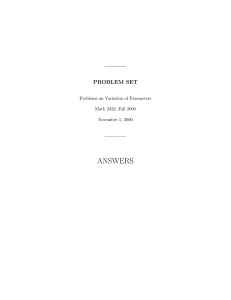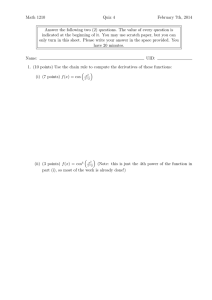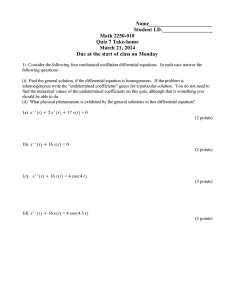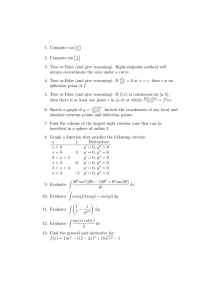Ordinary Differential Equations 1 Introduction 2 Classifying
advertisement
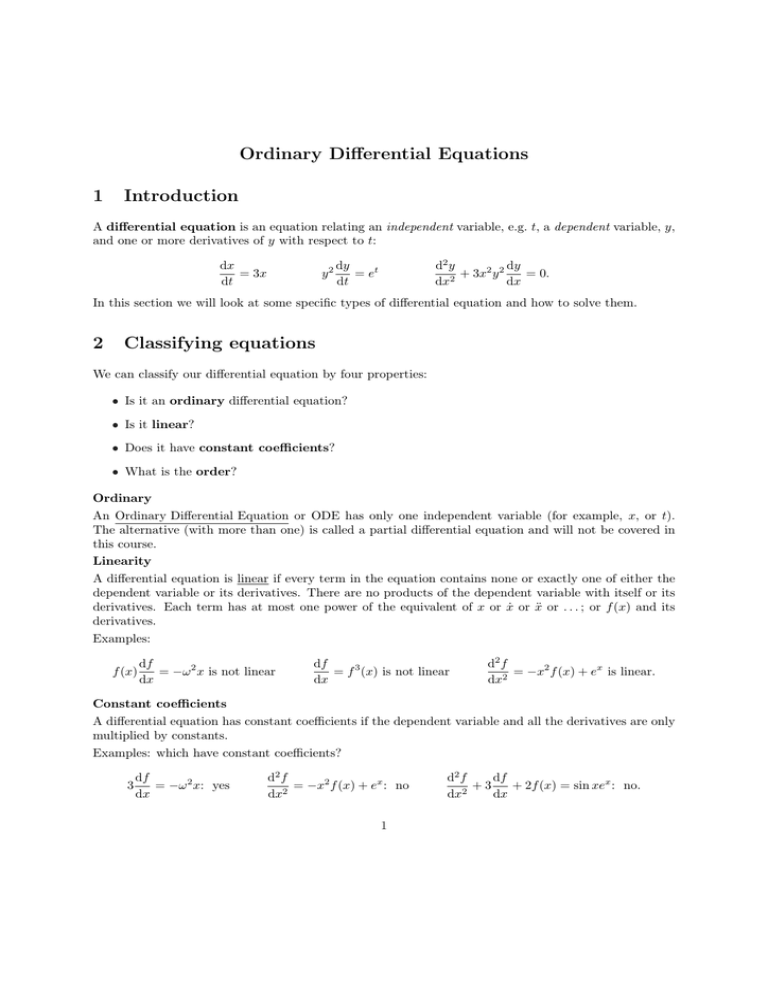
Ordinary Differential Equations 1 Introduction A differential equation is an equation relating an independent variable, e.g. t, a dependent variable, y, and one or more derivatives of y with respect to t: dx = 3x dt y2 d2 y dy = 0. + 3x2 y 2 dx2 dx dy = et dt In this section we will look at some specific types of differential equation and how to solve them. 2 Classifying equations We can classify our differential equation by four properties: • Is it an ordinary differential equation? • Is it linear? • Does it have constant coefficients? • What is the order? Ordinary An Ordinary Differential Equation or ODE has only one independent variable (for example, x, or t). The alternative (with more than one) is called a partial differential equation and will not be covered in this course. Linearity A differential equation is linear if every term in the equation contains none or exactly one of either the dependent variable or its derivatives. There are no products of the dependent variable with itself or its derivatives. Each term has at most one power of the equivalent of x or ẋ or ẍ or . . . ; or f (x) and its derivatives. Examples: f (x) df = −ω 2 x is not linear dx df = f 3 (x) is not linear dx d2 f = −x2 f (x) + ex is linear. dx2 Constant coefficients A differential equation has constant coefficients if the dependent variable and all the derivatives are only multiplied by constants. Examples: which have constant coefficients? 3 df = −ω 2 x: yes dx d2 f = −x2 f (x) + ex : no dx2 1 d2 f df +3 + 2f (x) = sin xex : no. dx2 dx Finally, a “trick” one: 3ex df + ex f (x) = x3 does have constant coefficients: divide the whole equation by ex . dx Order The order of a differential equation is the largest number of derivatives (of the dependent variable) ever taken. Examples: f (x) 3 df = −ω 2 x is 1st order dx d2 f = −x2 f (x)+ex is 2nd order dx2 d2 f d2 f df +3 2 = 0 is 2nd order. 2 dx dx dx First order linear equations First the general theory. A first order linear differential equation for y(x) must be of the form dy + p(x)y = q(x). dx If there is something multiplying the dy/dx term, then divide the whole equation by this first. Now suppose we calculate an integrating factor µZ ¶ I(x) = exp p(x) dx . Just this once, we won’t bother about a constant of integration. We multiply our equation by the integrating factor: I(x) dy + I(x)p(x)y = I(x)q(x). dx and then observe that d dy dI dy (yI(x)) = I(x) + y = I(x) + yp(x)I(x) dx dx dx dx which is our left-hand-side. So we have the equation d (yI(x)) = I(x)q(x) dx which we can integrate (we hope): Z yI(x) = y= 1 I(x) I(x)q(x) dx + C Z I(x)q(x) dx + C . I(x) We sort out the constant C from the initial conditions at the end. 2 Example dy + 2xy = 0 dx Here the integrating factor will be and µZ I(x) = exp and our equation is ex 2 y = 3 when x = 0. ¶ 2x dx = exp x2 2 dy + 2xex y = 0. dx 2 2 d h x2 i ye =0 =⇒ yex = C =⇒ y = Ce−x . dx The last thing we do is use the initial conditions: at x = 0, y = 3 but our form gives at x = 0, y = C so we need C = 3 and 2 y = 3e−x . 3 0 Example dy + 2y = sin x with y(π/2) = 0. dx First we need to get the equation into a form where the first term is just dy/dx: so divide by x: x dy 2 sin x + y= . dx x x Now we calculate the integrating factor: µZ ¶ 2 I(x) = exp dx = exp (2 ln x) = exp ln (x2 ) = x2 . x We multiply the whole system by x2 : x2 dy + 2xy = x sin x dx and now we can integrate: d 2 (x y) = x sin x dx Z x2 y = =⇒ 3 x sin x dx + C which we can integrate by parts: Z 2 x y = −x cos x + cos x dx + C = −x cos x + sin x + C so the general solution is cos x sin x C + 2 + 2. x x x Finally, we use the initial condition y = 0 when x = π/2 to get y=− 0=− cos (π/2) sin (π/2) C 1 C + + =0+ + . (π/2) (π/2)2 (π/2)2 (π/2)2 (π/2)2 which means C = −1 and our solution is y=− cos x 1 − sin x − . x x2 Example This time we will solve two different differential equations in parallel. dy + 3y = e−2x dx and df + 3f = e−3x dx In this example, we don’t actually have variable coefficients – but that just makes it easier! Z In both cases, I(x) = exp 3 dx = e3x . e3x dy + 3e3x y = ex dx d ¡ 3x ¢ e y = ex dx e3x y = ex + C0 y = e−2x + C0 e−3x 4 and and and and df + 3e3x f = 1. dx d ¡ 3x ¢ e f = 1. dx e3x e3x f = x + C1 . f = xe−3x + C1 e−3x . Homogeneous linear equations. A homogeneous linear equation is one in which all terms contain exactly one power of the dependent variable and its derivatives: dy d2 y +5 + 6y = 0. e.g. dx2 dx For these equations, we can add up solutions: so if f (x) is a solution and g(x) is a solution: df d2 f +5 + 6f = 0 dx2 dx and 4 d2 g dg +5 + 6g = 0 dx2 dx then so is af (x) + bg(x) for any constants a and b: d2 d [af (x) + bg(x)] + 5 [af (x) + bg(x)] + 6[af (x) + bg(x)] = 0. dx2 dx An nth order homogeneous linear equation will “always” (i.e. if it is well-behaved: don’t worry about this detail) have exactly n independent solutions y1 , . . . , yn and the general solution to the equation is y = c1 y1 + c2 y2 + · · · + cn yn . 4.1 Special case: coefficients axr Suppose we are given a differential equation in which the coefficient of the rth derivative is a constant multiple of xr : d2 y dy e.g. x2 2 + 2x − 6y = 0. dx dx m Then if we try a solution of the form y = x we get dy d2 y = mxm−1 = m(m − 1)xm−2 dx dx2 and if we put this back into the original equation we get y = xm x2 m(m − 1)xm−2 + 2mxxm−1 − 6xm = 0 xm (m(m − 1) + 2m − 6) = 0 xm (m2 + m − 6) = 0. Now xm will take lots of values as x changes so we need (m2 + m − 6) = 0 =⇒ (m − 2)(m + 3) = 0. In this case we get two roots: m1 = 2 and m2 = −3. This means we have found two functions that work as solutions to our differential equation: y1 = xm1 = x2 and y2 = xm2 = x−3 . But we know that if we have two solutions we can use any combination of them so our general solution is y = c1 x2 + c2 x−3 . This works with an nth order ODE as long as the nth order polynomial for m has n different real roots. Example x2 Try y = xm : y = xm m(m − 1)xm − 6mxm + 10xm d2 y dy − 6x + 10y = 0. dx2 dx dy d2 y = mxm−1 = m(m − 1)xm−2 . dx dx2 = 0 =⇒ xm (m2 − m − 6m + 10) = 0 =⇒ xm (m − 5)(m − 2) = 0. The general solution to this equation is y = c1 x5 + c2 x2 . 5 4.2 Special case: constant coefficients. Now suppose we have a homogeneous equation with constant coefficients, like this one: d2 y dy +5 + 6y = 0. dx2 dx We try a solution y = eλx . This gives dy/dx = λeλx and d2 y/dx2 = λ2 eλx so λ2 eλx + 5λeλx + 6eλx = 0. (λ2 + 5λ + 6)eλx = 0 for all x. Just like the polynomial case, the function of x will not be zero everywhere so we need λ2 + 5λ + 6 = 0 =⇒ (λ + 2)(λ + 3) = 0. In this case we get two roots: λ1 = −2 and λ2 = −3. This means we have found two independent solutions: y1 = eλ1 x = e−2x and y2 = eλ2 x = e−3x , and the general solution is y = c1 e−2x + c2 e−3x . Example A third-order equation this time: d2 y dy d3 y − −2 = 0. 3 3 dx dx dx Trying y = eλx gives λ3 − λ2 − 2λ = 0 =⇒ λ(λ2 − λ − 2) = 0 =⇒ λ(λ − 2)(λ + 1) = 0 which has three roots, λ1 = 0 The general solution is λ2 = 2 λ3 = −1. y = c1 e0x + c2 e2x + c3 e−x = c1 + c2 e2x + c3 e−x . Notice that we have three constants here: in general we will always have N constants in the solution to an N th order equation. Example Another second-order equation: Trying y = eλx gives d2 y dy +2 + 5y = 0. dx2 dx λ2 + 2λ + 5 = 0 6 which has two roots, λ= −2 ± √ 4 − 20 2 = −2 ± √ −16 2 = −1 ± 2i. The general solution is then y = Ae(−1+2i)x + Be(−1−2i)x = e−x [Ae2ix + Be−2ix ] where A and B will be complex constants: but if y is real (which it usually is) then we can write the solution as y = e−x [c1 sin 2x + c2 cos 2x]. Repeated roots If our polynomial for λ has two roots the same, then we will end up one short in our solution. This is similar to the case with a repeated eigenvalue in the previous section: there, we used a generalised eigenvector and a function xeλx . Here we only need the xeλx part. Example Another third-order equation: d3 y d2 y dy −2 3 + = 0. 3 dx dx dx Trying y = eλx gives λ3 − 2λ2 + λ = 0 =⇒ λ(λ2 − 2λ + 1) = 0 =⇒ λ(λ − 1)2 = 0 which has only two distinct roots, λ1 = 0 The general solution is 5 λ2 = λ3 = 1. y = c1 e0x + c2 ex + c3 xex = c1 + c2 ex + c3 xex . Inhomogeneous linear equations. What happens if there is a term with none of the dependent variable? That is, loosely, a term on the right hand side, or a function of x. f2 (x) d2 y dy + f1 (x) + f0 (x)y = g(x). dx2 dx In the most general case we can’t do anything: but in one or two special cases we can. If we already know the general solution to the homogeneous equation: f2 (x) d2 y dy + f1 (x) + f0 (x)y = 0 2 dx dx 7 =⇒ y = c1 y1 (x) + c2 y2 (x) then all we need is a particular solution to the whole equation: one function u(x) that obeys f2 (x) d2 u du + f1 (x) + f0 (x)u = g(x). dx2 dx Then the general solution to the whole equation is y = c1 y1 (x) + c2 y2 (x) + u(x). The solution to the homogeneous equation is called the complementary function or CF; the particular solution u(x) is called the particular integral or PI. Finding it involves a certain amount of trial and error! Special case: Coefficients xr In this case, we can only cope with one specific kind of RHS: a polynomial. We will see this by example: x2 d2 y dy − 6x + 10y = 6x3 . dx2 dx The homogeneous equation in this case is one we’ve seen before: x2 d2 y dy − 6x + 10y = 0 dx2 dx =⇒ y = c1 x5 + c2 x2 . Now as long as the power on the right is not part of the CF we can find the PI by trying a multiple of the right hand side: dy d2 y y = Ax3 =⇒ = 3Ax2 and = 6Ax. dx dx2 d2 y dy − 6x + 10y = x2 6Ax − 6x3Ax2 + 10Ax3 = x3 [6A − 18A + 10A] = −2Ax3 dx2 dx so for this to be a solution we need −2A = 6 so A = −3. Then the general solution to the full equation is y = c1 x5 + c2 x2 − 3x3 . x2 A couple of words of warning about this kind of equation: • If the polynomial for the power m has a repeated root then we fail • If the polynomial for the power m has complex roots then we fail • If a power on the RHS matches a power in the CF then we fail. Special case: constant coefficients Given a linear ODE with constant coefficients, we saw in the previous section that we can always find the general solution to the homogeneous equation (using eλx , xeλx and so on), so we know how to find the CF. There are a set of standard functions to try for the PI, but that part is not guaranteed. 8 Example First we need the CF. Try y = eλx d2 y dy −3 + 2y = e−x . 2 dx dx on the homogeneous equation: λ2 − 3λ + 2 = 0 =⇒ (λ − 1)(λ − 2) = 0. So there are two roots, λ1 = 1 and λ2 = 2. The CF is then yCF = c1 ex + x2 e2x . Next we need the PI. Since the RHS is e−x , we try the form y = Ae−x dy = −Ae−x dx d2 y = Ae−x . dx2 d2 y dy −3 + 2y = Ae−x + 3Ae−x + 2Ae−x = 6Ae−x dx2 dx so we need A = 1/6 for this to work. Our PI is yPI = and the general solution is 1 −x e 6 1 y = c1 ex + x2 e2x + e−x . 6 Example dy + 3y = e−3x . dx This is only first-order: in fact we solved it in section 3 and the solution was y = xe−3x + C1 e−3x . Let us solve it the way we have just learned. First the CF: try y = eλx then λ+3=0 so λ = −3 and the CF is yCF = C1 e−3x . Now look for the PI. The RHS is e−3x so our first thought might be to try Ae−3x . But this is the CF: so we know when we try it we will get zero! So instead (motivated by knowing the answer in this case) we multiply by x and try dy y = Axe−3x = Ae−3x − 3Axe−3x dx dy + 3y = Ae−3x − 3Axe−3x + 3Axe−3x = Ae−3x . dx so we need A = 1 and we end up with the same solution we got last time. In general, if the RHS matches the CF (or part of the CF) then we will multiply by x to get our trial function for the PI. 9 Example This time we have initial conditions as well: remember we always use these as the very last thing we do. d3 y d2 y dy dy d2 y +2 2 + = 2x with y = 3, = −4 and = 4 at x = 0. 3 dx dx dx dx dx2 First we find the CF. Try y = eλx : λ3 + 2λ2 + λ = 0 =⇒ λ(λ2 + 2λ + 1) = 0 =⇒ λ(λ + 1)2 = 0. This has only two distinct roots: λ1 = 0, λ2 = λ3 = −1. Therefore the CF is: yCF = c1 + c2 e−x + c3 xe−x . Now we look for the PI. The RHS is x so we try a function y = Ax + B =⇒ dy d2 y d3 y = A =⇒ = = 0. 2 dx dx dx3 This makes d3 y d2 y dy +2 2 + =0+0+A 3 dx dx dx and no value of A can make this equal to x. What do we do when it fails? • If the trial function fails, try multiplying by x. [Note: in this case we could have predicted this because the B of our trial function is part of the CF.] We want one more power of x so we try y = Cx2 + Ax =⇒ dy d2 y d3 y = 2Cx + A =⇒ = 2C and = 0. dx dx2 dx3 d3 y d2 y dy + 2 + = 0 + 4C + 2Cx + A dx3 dx2 dx so we need 2Cx + 4C + A = 2x Our general solution is which means C = 1, A = −4. y = c1 + c2 e−x + c3 xe−x + x2 − 4x. Now we apply the initial conditions: y = c1 + c2 e−x + c3 xe−x + x2 − 4x dy = −c2 e−x + c3 e−x − c3 xe−x + 2x − 4 dx d2 y = c2 e−x − 2c3 e−x + c3 xe−x + 2 dx2 =⇒ =⇒ =⇒ y(0) = c1 + c2 = 3 dy (0) = −c2 + c3 − 4 = −4 dx d2 y (0) = c2 − 2c3 + 2 = 4 dx2 The solution to this linear system is c2 = −2, c3 = −2, c1 = 5 so our final answer is y = 5 − 2e−x − 2xe−x + x2 − 4x. 10 Table of functions to try for PI f (x) αekx αekx αekx sin kx cos kx sin kx sin kx xn xn xn Conditions on CF λ = k not a root λ = k a root λ = k a double root λ = ik not a root λ = ik not a root λ = ik a root λ = ik a double root λ = 0 not a root λ = 0 a root λ = 0 a double root 11 First guess at PI Aeλx Axeλx Ax2 eλx A cos kx + B sin kx A cos kx + B sin kx Ax cos kx + Bx sin kx Ax2 cos kx + Bx2 sin kx Axn + Bxn−1 + · · · + C Axn+1 + Bxn + · · · + Cx Axn+2 + Bxn+1 + · · · + Cx2 6 Summary of differential equations Yes ¶ ³ No Is it an ODE? µ ´ Yes ? ¶ ³ No Is it linear? µ ´ ' ? ¶ ³ Does it have No Is it first order? constant µ ´ coefficients? & Yes Yes ? ? Integrating CF & PI factor using method eλx @ R Beyond @ this - course 6 No $ ' Are the coefficients No - powers of x matching the derivatives? % & Yes ? CF & PI using xm $ % First-order linear ODEs R dy + p(x)y = q(x), we calculate an integrating factor I(x) = e p(x) dx dx R R d ³ R p dx ´ dy R p dx e +p(x)ye p dx = ye = q(x)e p dx . dx dx Z Z To solve an equation of the form and multiply by it: We integrate both sides: ye R p dx = q(x)e R p dx dx+C =⇒ y = e− R p dx q(x)e R p dx dx+Ce− R p dx . Linear ODEs with constant coefficients d2 y dy +b +cy = f (x) we calculate the CF, by trying solutions of the dx2 dx for the homogeneous equation (RHS=0). If there is a repeated root we use eλx and xeλx : To solve an equation of the form a form y = eλx yCF = c1 eλ1 x + c2 eλ2 x or yCF = c1 eλx + c2 xeλx . We calculate the PI, which is any solution to the original equation, by a system of trial and error. In general we try something of the same form as f (x); if this overlaps with the CF at all then we multiply by x. The general solution is y = yCF + yPI . Linear ODEs with xn -type coefficients d2 y dy + bx + cy = xn we calculate the CF, by trying solutions of dx2 dx the form y = xm for the homogeneous equation. As long as the roots m are real, different and not equal to n this is OK. Then we use y = Axn as the PI. To solve an equation of the form ax2 12
